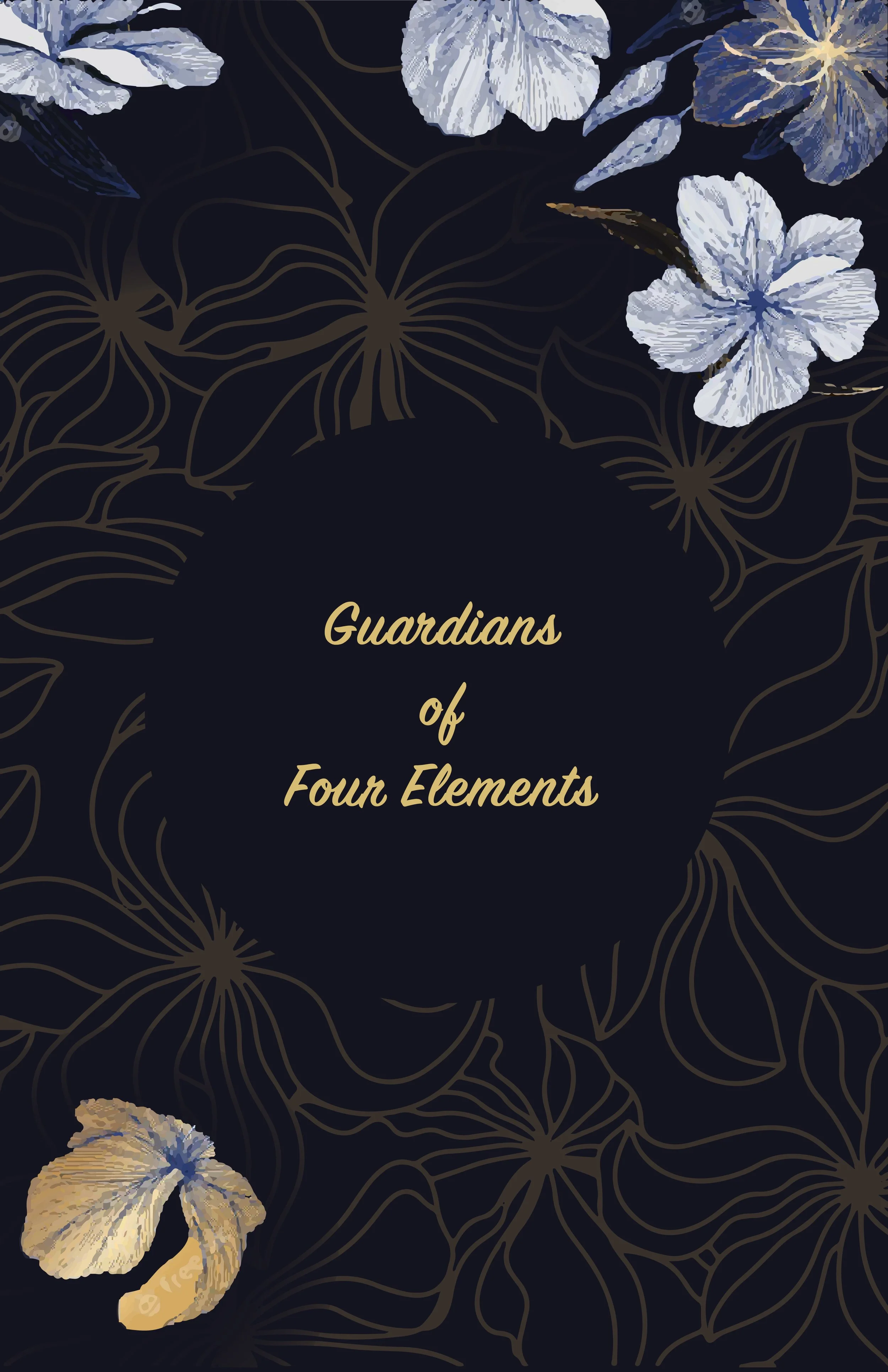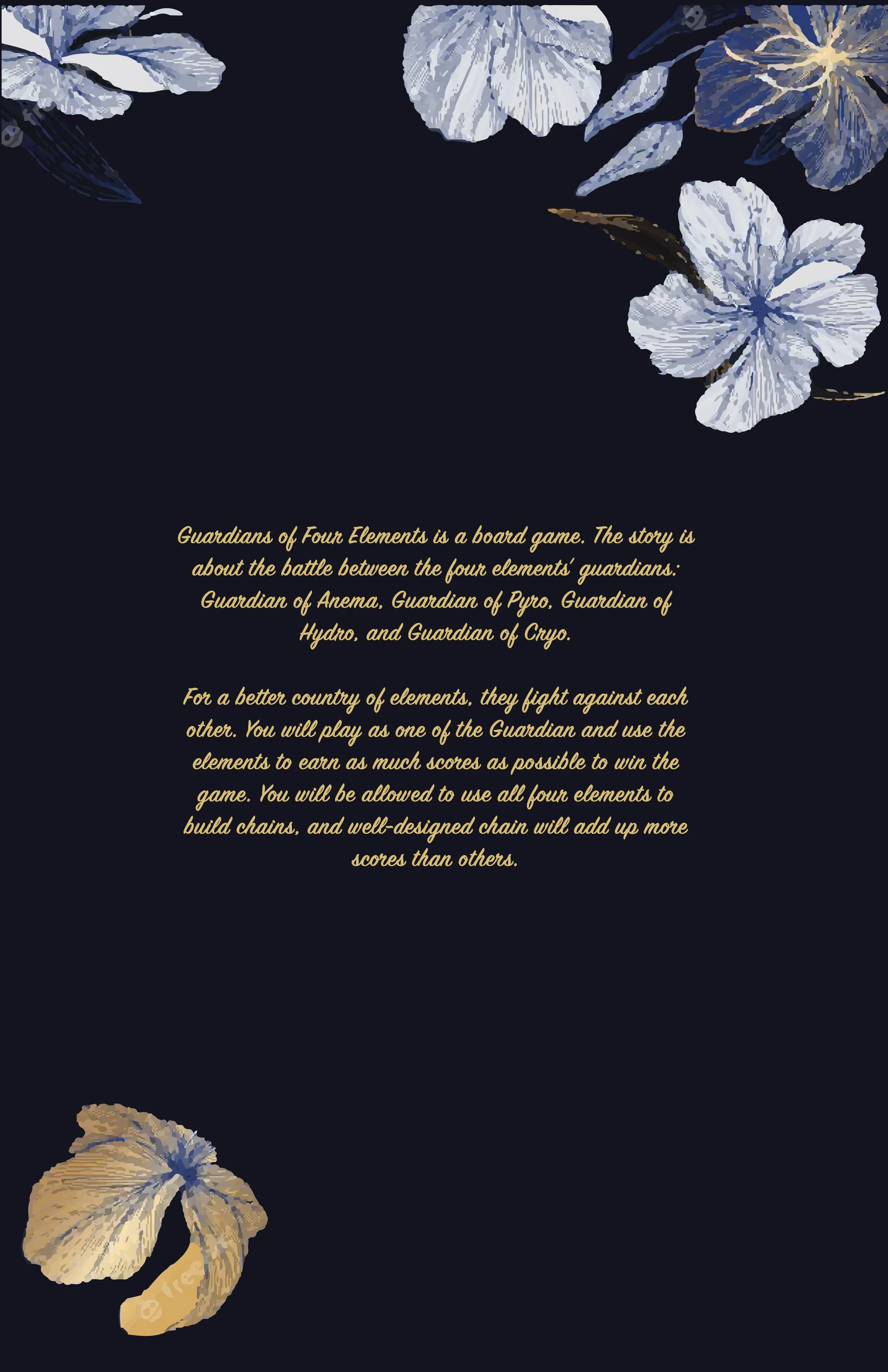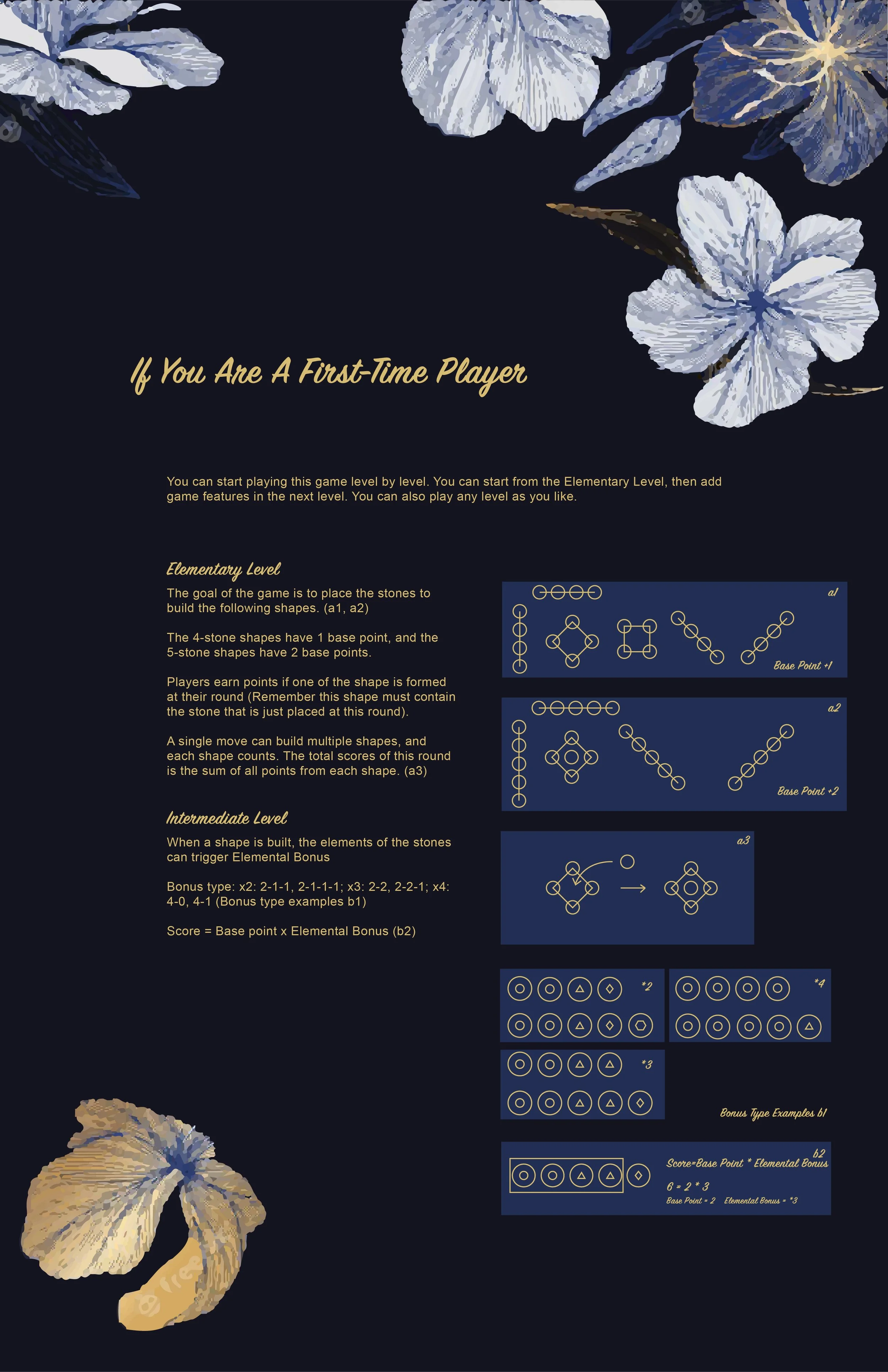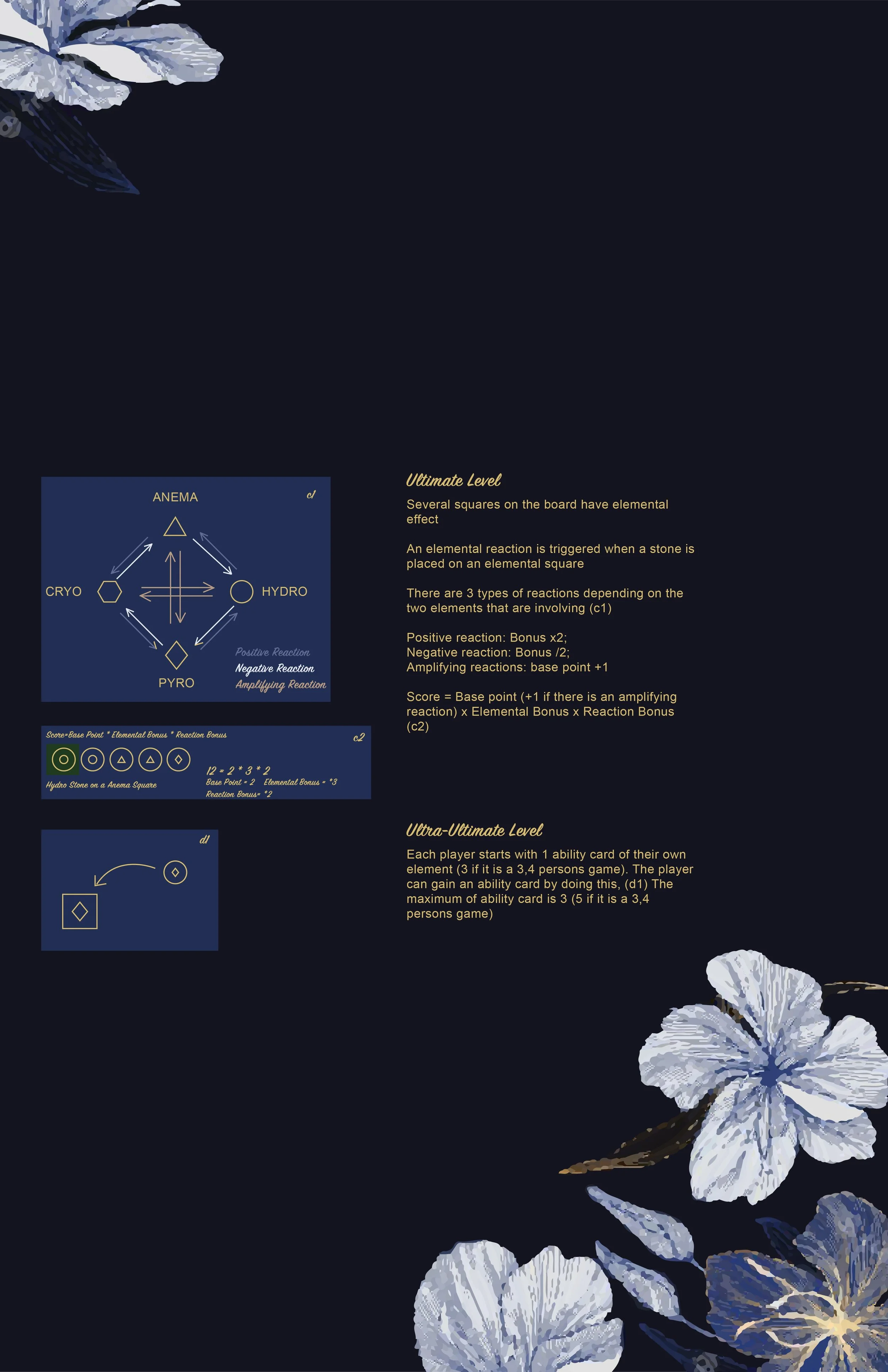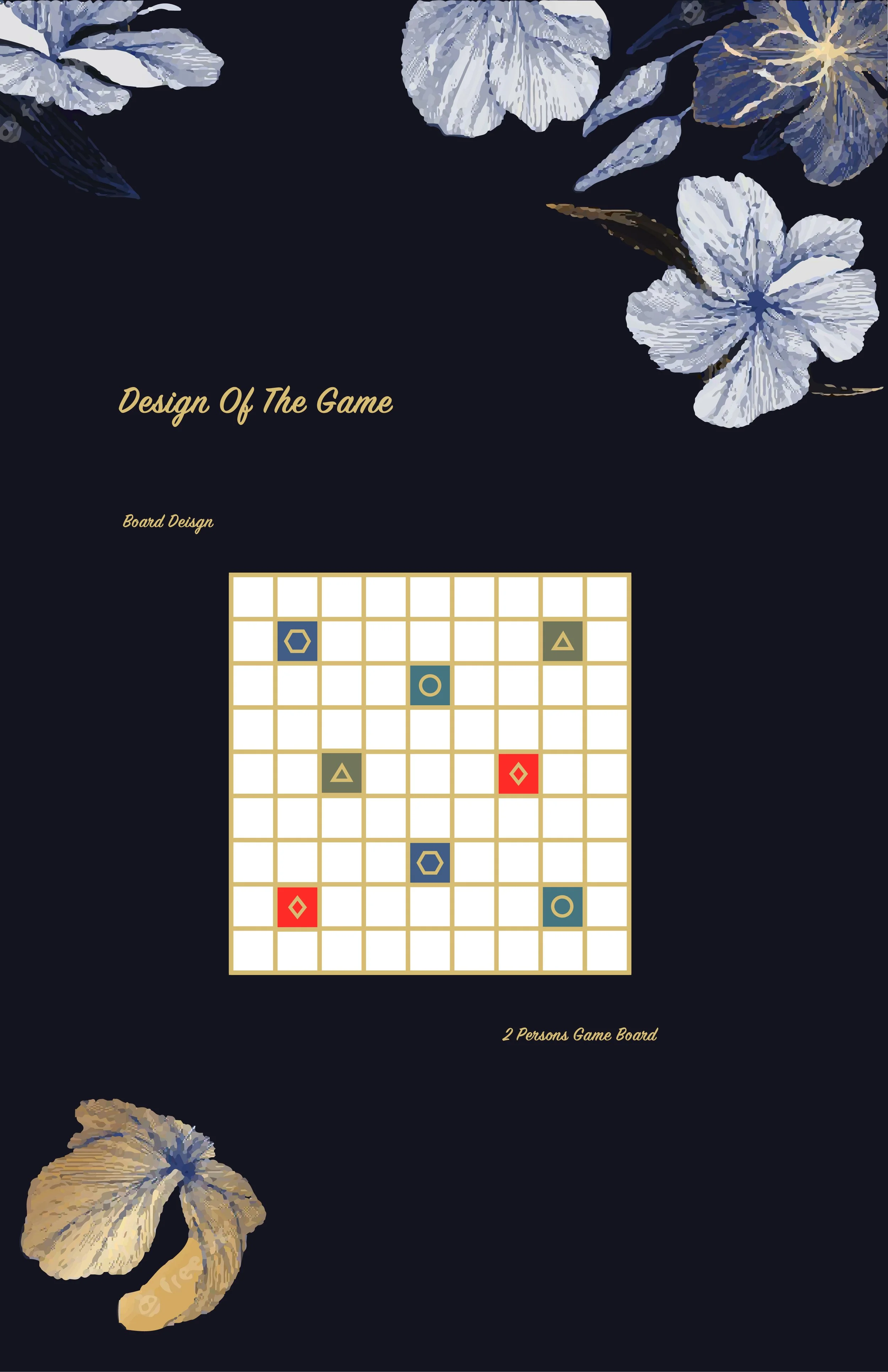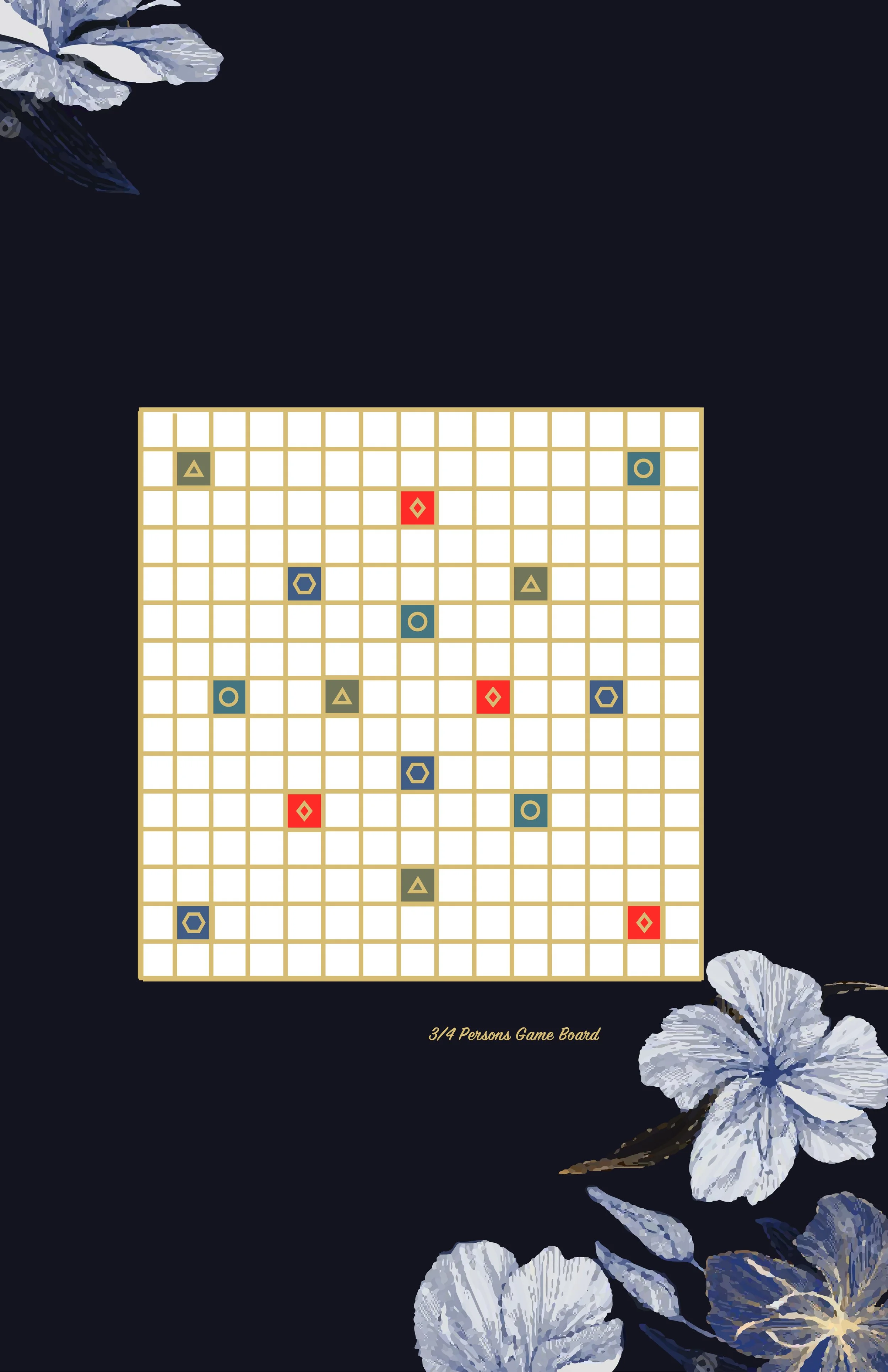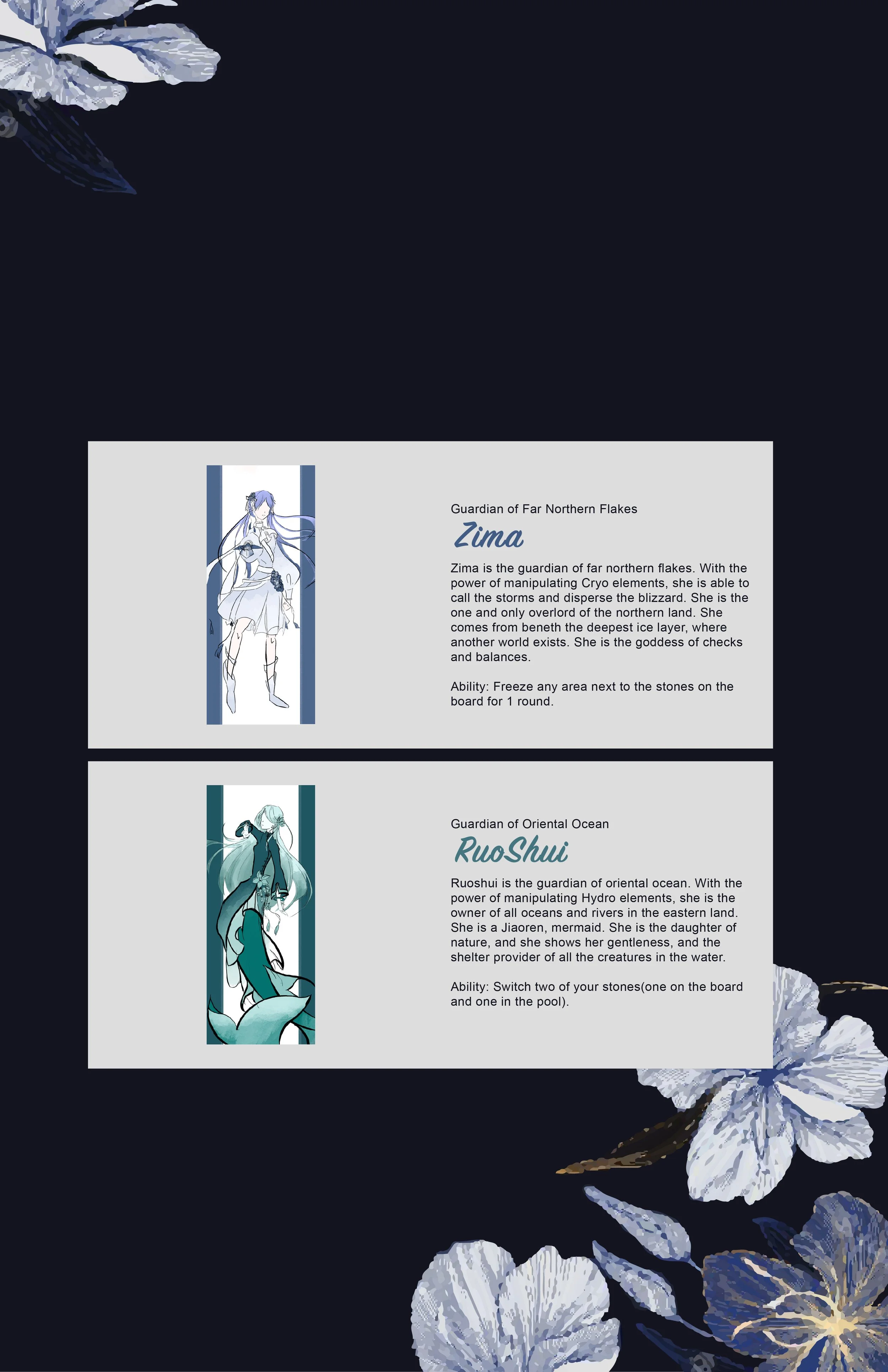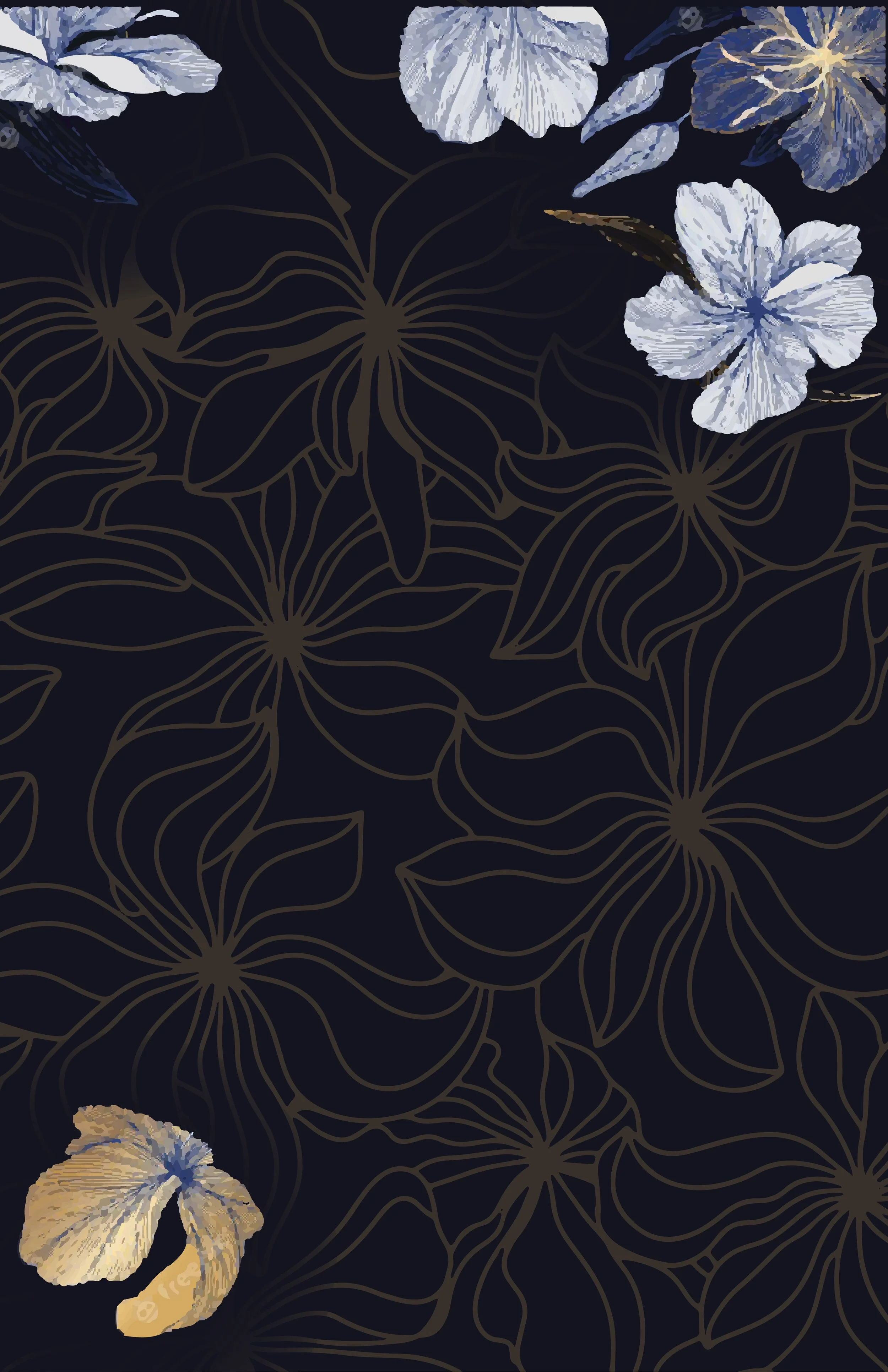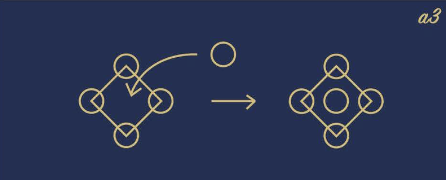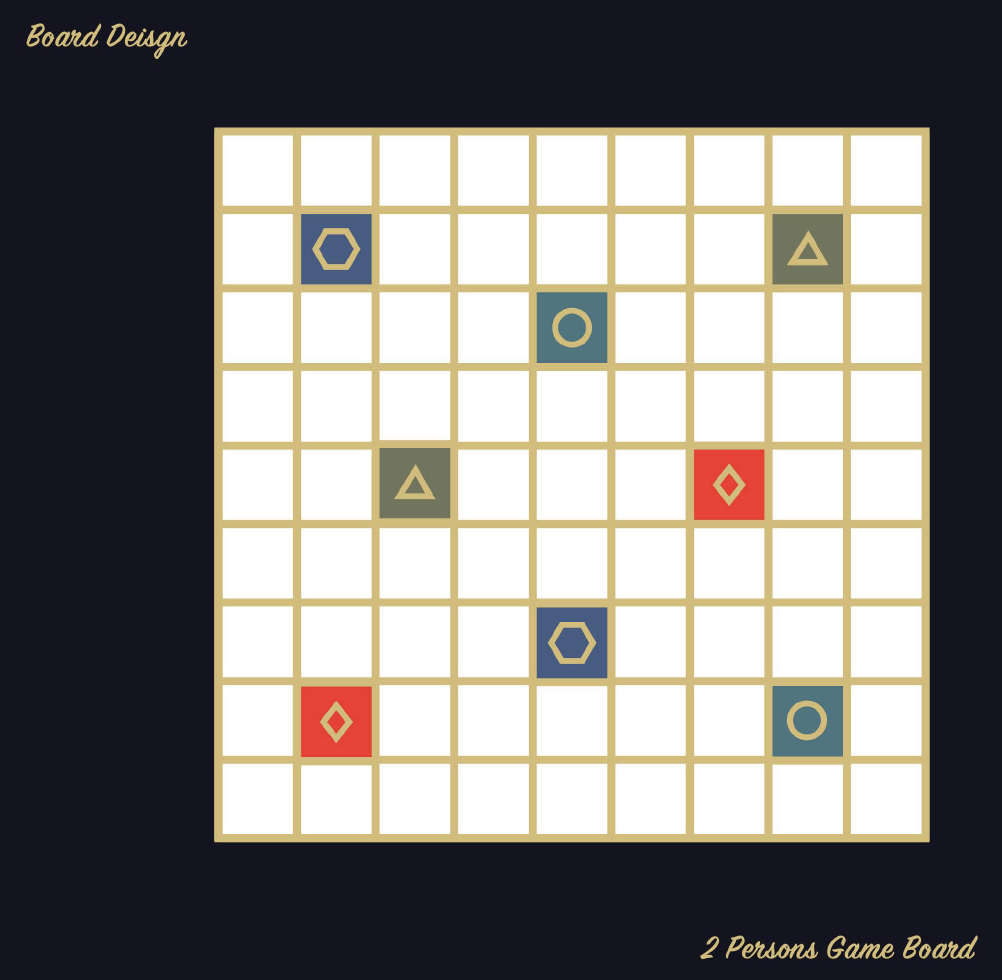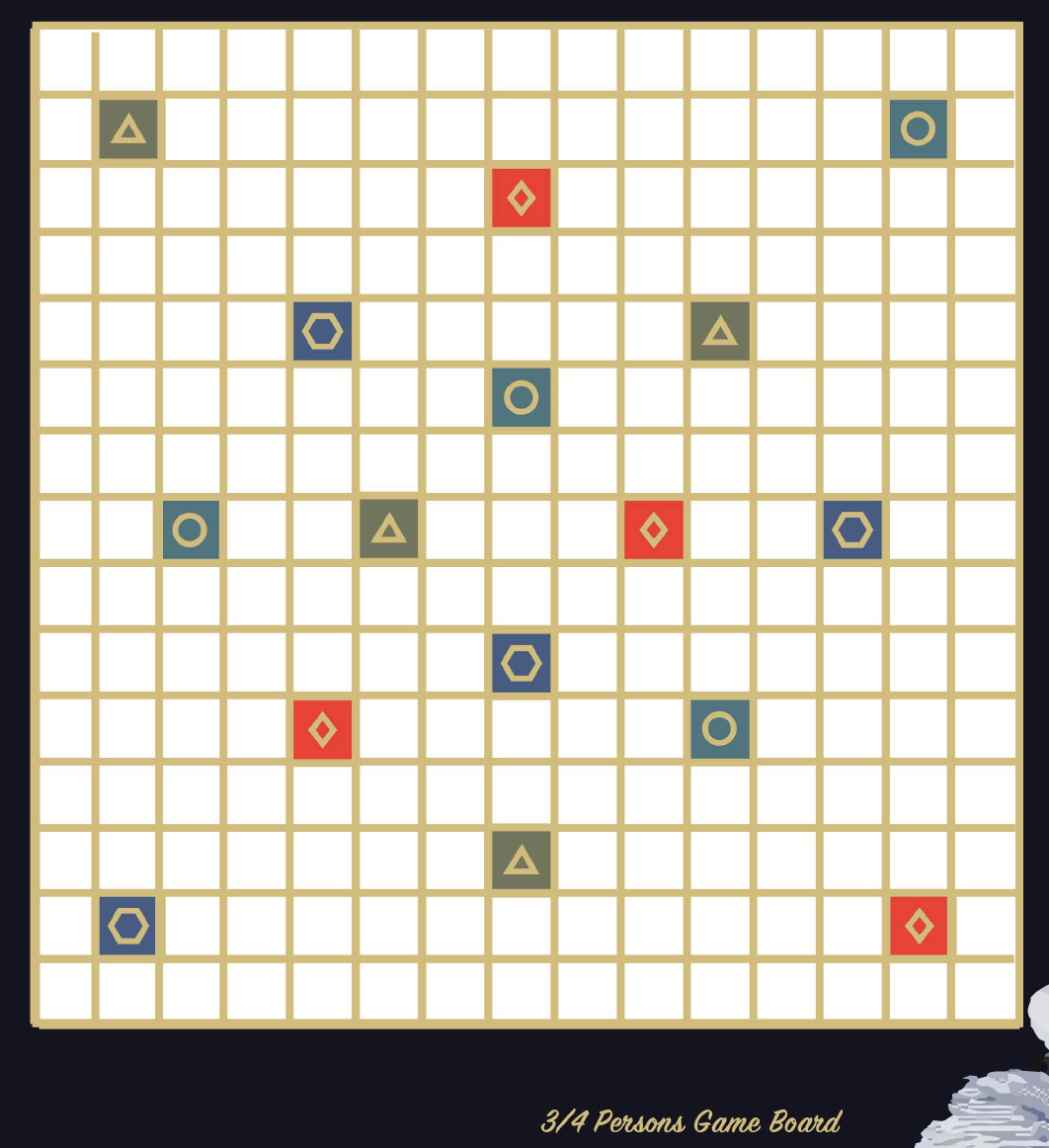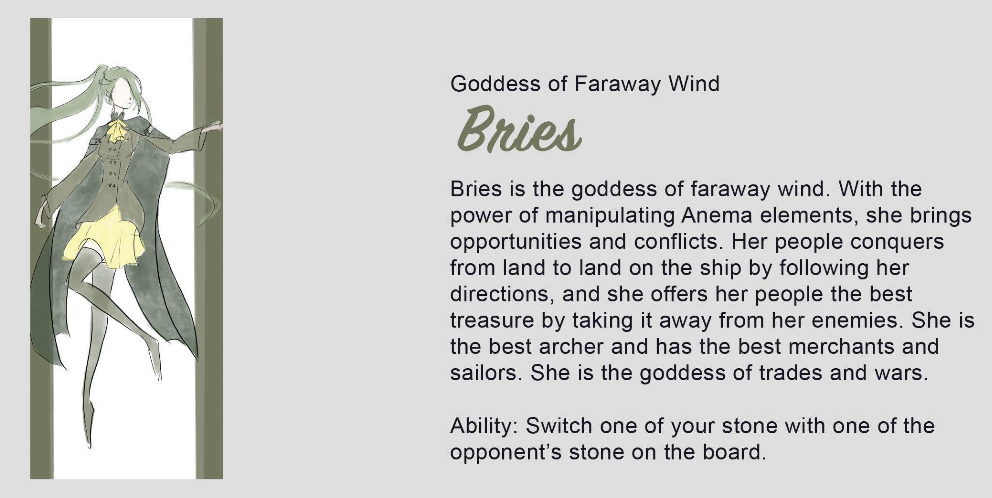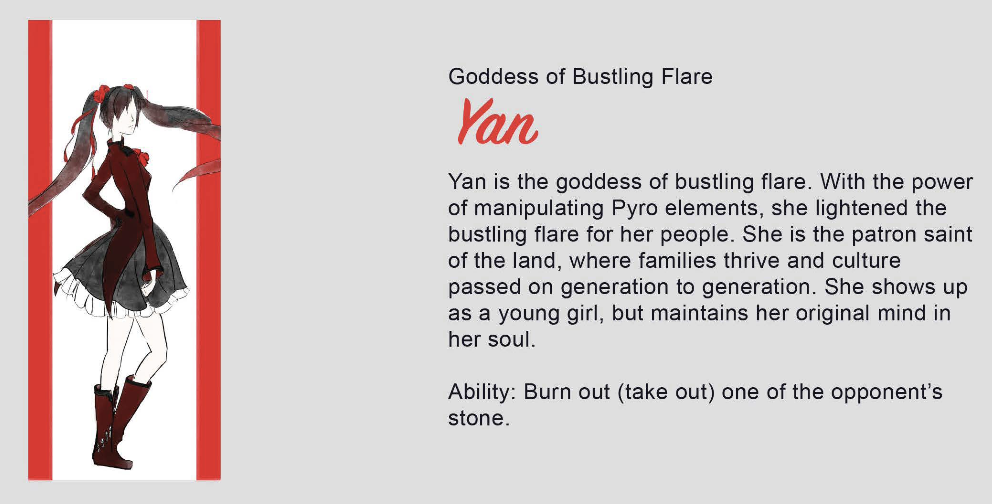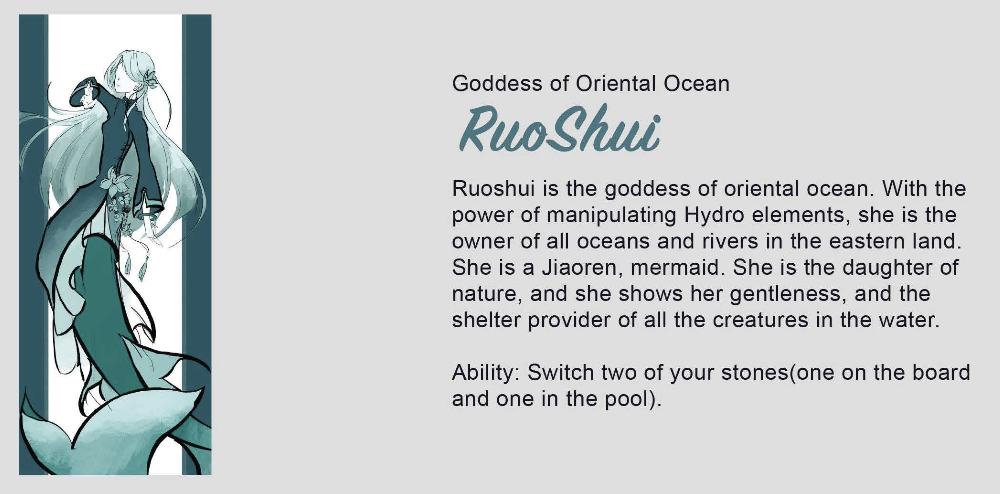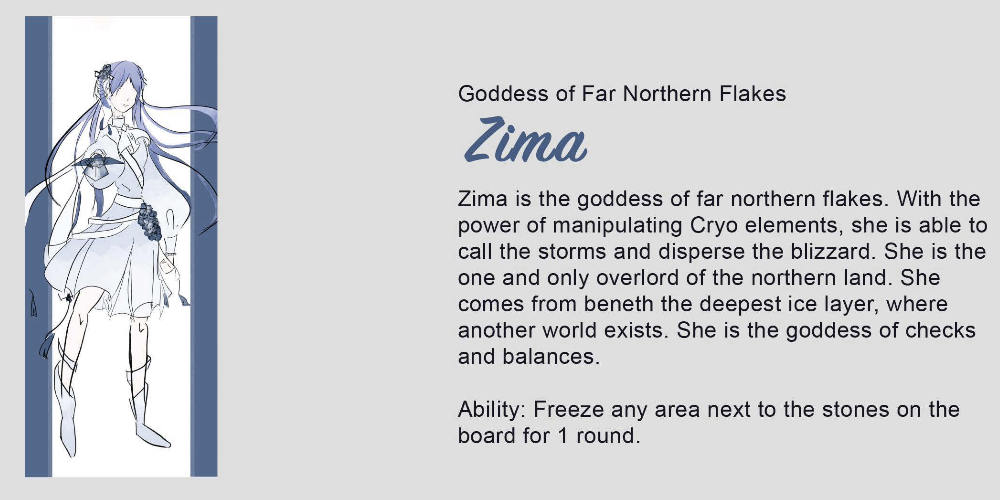Game Design Project
GUARDIANS OF FOUR ELEMENTS/a board game.
Dec. 2021
Have you ever thought about when one of the most traditional board games, Gomoku, meets with the fantasy world? Guardians of Four Elements, the board game, is altered from the very basic Gomoku rules and added the fantasy settings. It is an easy pickup game for best friends of 2-4 parties. Each round is about 20-40 minutes, depending on the hard level and numbers of players. The unique level design would allow even younger players to start playing in 10 minutes. The total of five levels of play experience would provide players a gradual and easy learning experience as well as choices of different play modes for players to make. The character representation feature would give players a unique yet more immersive experience of a board game. Now is the time to protect your realm, and expand the reign of your elements!
How It Starts…
I was very obsessed with the game, Genshin Impact. The experience of building a team by combining different characters with different elements got me hooked, and the combinations of the elements impressed me a lot.
Then the idea came to my mind:
What if I use the concept of combining the elements to build a board game? The key mechanic would be based on the different combinations of the elements.
To start, it naturally led me to the traditional game Gomoku, which is familiarized by most people back in China.
The mechanics of Gomoku is to put five stones in a line. The first player who successfully puts five stones in a row(horizontally, vertically and diagonally) wins the game. I took the idea of putting stones into shapes of Gomoku, and added my own stuff to it.
The Design Process
The key mechanic is the combinations and reactions of the elements.
There will be four elements, Pyro, Cryo, Hydro and Anemo. All of the elements can be combined with each other. However, depending on the different combinations, there would be different reactions. The different reactions would largely affect the final scores. The goal for the game is to earn as many points as possible within the limited round.
After designing the mechanics of elements and combinations, I started to design the reactions. I created three different types of reactions: Positive Reaction, Negative Reaction and Amplifying Reaction. Below is the instruction of elements and reactions:
Then I added the boosting system to the game.
Whenever there is a reaction triggered, a booster of points would apply to the score. Below is the instructions and examples of boosting system:
Now the design process comes to how players could earn their scores, including the rules, winning conditions and the limits.
First of all, I went back to the idea I took from Gomoku, and altered it into my version of the game. Players would have their own colors of stones to build different shapes to earn points. Below is the shapes that counts for points:
When the shape is built, a point of the shape would be counted. It would be affected by the number of the stones the player used to build the shape, and the elemental reactions they triggered to boost the points.
The stones are ready, but the board design is what surprised me the most.
I was lost at the beginning of the board design. I don’t know how large the board should be, nor how many checks I should put. I took out my board games, and researched on the ratio of the numbers of the stones versus the numbers of the checks. Then I chose the board from one of the board games I have, Latice Pacific, to play my game. The experience of the gameplay was good, and I decided to go with the size of that board, 9 by 9. Then I made my own board which contains a 9 by 9 board for 2 players, and 15 by 15 board for 3-4 players. I did the modification of the size of the board later on, because I wanted to limit players into a smaller board so that there would be more conflict. Players would be more likely to go against each other instead of building their own shapes in a smaller board, which increases the conflict in the gameplay.
To make it more complicated and interesting, I added the elements to the board where players are not only combining the elements in the shape, but also the reactions between stones and board.
Now the basic mechanics are designed. I felt it was not attractive enough, and I wanted to add the emotional tie to the game.
Then I started to work on the background design of the world and the character design of the four guardians.
I created the story of how four guardians need to guard their own realms and expand their reigns by battling with other guardians. I drew the characters by myself, and I added different cultural elements into their design. These are all preparing for my last mechanic, the character abilities.
When I design the character abilities, which is the very difficult part of the game design, I try to combine the culture from the real world, different character temperaments and the balance of each character's abilities. I designed the appearance of the characters while I designed their abilities. I brought them into person while I tested different character abilities. It was really fun when I was working on their clothing, their hairdo and their weapons. However, it was the most difficult time in the game design process to find the balance of the character abilities. I did many playtestings with my family members, and modified them several times. I also tried to keep some of the abilities more aggressive while the others are more controlling to bring a variety of experiences for different players.
That is pretty much the struggling yet super fun process of how the board game comes to reality. However, I met another issue:
How am I going to introduce that many rules to the players at once?
The answer is, don’t do it at once, or they will look at me with the most confusing eyes I have ever seen in my whole life.
That is when the level design comes to the mind.
The Level Design
The level design of this board game is designed to teach players how to play the game gradually. It is also the method I used to test the game. I split the mechanics into 4 levels, and added one new feature when it comes to the next level.
Here is the description of each level:
Elementary-level:
The goal of the game is to place the stones to build the following shapes.
The 4-stone shapes have 1 base point, and the 5-stone shapes have 2 base points.
Players earn points if one of the shape is formed at their round (Remember this shape must contain the stone that is just placed at this round).
A single move can build multiple shapes, and each shape counts. The total scores of this round is the sum of all points from each shape.
Intermediate-level:
When a shape is built, the elements of the stones can trigger Elemental Bonus
Bonus type: x2: 2-1-1, 2-1-1-1; x3: 2-2, 2-2-1; x4: 4-0, 4-1
Score = Base point x Elemental Bonus
Ultimate-level:
Several squares on the board have elemental effect
An elemental reaction is triggered when a stone is placed on an elemental square
There are 3 types of reactions depending on the two elements that are involving
Positive reaction: Bonus x2; Negative reaction: Bonus /2; Amplifying reactions: base point +1
Score = Base point (+1 if there is an amplifying reaction) x Elemental Bonus x Reaction Bonus
Ultra-Ultimate-level:
Character ability introduced in this level.
After designing the levels, I found the game is easy to be explained and tested, and each level is fun enough to play separately. I found it worthy to play in all four levels, which suddenly increased the ways to play the game.
Character Design
The game functional wise is good to go, however, I am not satisfied with the character design.
I was planning to make a board game having the features of RPG games. Players are not only considering the strategies in the game, but also the emotional tie to their characters and perspectives. In addition, the character design so far is too simple that neither the images nor the details are satisfactory. Not to mention the character is not really making sense of their abilities. As a result, I redo some of the images - Since I’m not a professional artist, the art needs to be improved a lot - and write down the bios of each character. Their stories are connecting their own experience derived from the real culture and their ability. Below are the final character design and their background stories:
Anemo: I took the idea of Dutch sailors and ships in the 17th century, who did the largest trade and started the most wars at that moment. Her name is Bries, means the wind in Dutch.
Pyro: Pyro is the one representing the thriving eastern culture. I used the traditional Chinese clothes, and changed it to align with the fantasy tone. I changed the image of the spare into a peach blossom branch, representing the prosperity she brought to the country. Her name: Yan, means fire and burning in Chinese.
Hydro: Hydro also derives from the Eastern culture. I designed the image of her as a mermaid, and it is also “Jiaoren” in Chinese. Chinese mermaids have different legends compared to the ones in the western. Jiaoren are the most beautiful and powerful creatures in the world. They live in the ocean, and protect their homeland from destruction by the land creatures. Their voices are the prettiest in the world, and their tears become pearls. I used the image of this legendary creature to design Ruoshui. Ruoshui means every single water in Chinese. I wanted to create a character who is beautiful, powerful yet soft.
Cryo: Cryo is a special character comparing to others. I was designing a guardian who came from the other world, which ended up in the setting of Zima. She comes from beneath the far northern land, and she is the guardian who has the power to control the rhythm of battle between the guardians.
It was quite fun to do the character design like this. I am absolutely not a professional artist, and the character card design is not perfect. I am still glad to bring the image and idea in my mind to the real world.
Post-Mortem
This is the first time I designed a board game. I always feel that board games are something replaceable. The feeling of actually holding the stones and placing them on board is a huge part of the fun of playing the board game. It is also hard to design a playable board game. There are many other things that could be the complementary experience of mechanics in the video game, however, board game design is mostly mechanics design. The outcomes of a board game are largely dependent on the mechanics. As a result, I had a very decent experience of designing mechanics by designing this board game.
One of the most important things I learnt is a trick to design the game. I found the trick to design it by thinking about what I encourage players to do and what I do not. I think about it whenever I need to adjust something or add some more features. I gave rewards where players did what I encouraged them to, and I gave punishments where players did the reverse. The design of the reactions of elements is the best example. In order to encourage players thinking about different combinations, I gave twice the point for some combinations while half the others.
The most satisfying part of the board game was the level design. I was designing it for players to learn how to play the game easier, however it enhanced the play experience a lot and gave players more options to play the game at the end.
The most interesting part of the game is the character design. Despite how much I love creating characters, the connection between the characters themselves and their abilities really gives me a chance to think about the efficiency of character design.
Last but not the least, I would continue on developing this game. The journey is not the end, and I am looking forward to seeing one day it could come to the market and people would love it.
It all begins with an idea. Maybe you want to launch a business. Maybe you want to turn a hobby into something more. Or maybe you have a creative project to share with the world. Whatever it is, the way you tell your story online can make all the difference.
Don’t worry about sounding professional. Sound like you. There are over 1.5 billion websites out there, but your story is what’s going to separate this one from the rest. If you read the words back and don’t hear your own voice in your head, that’s a good sign you still have more work to do.
